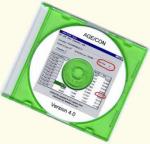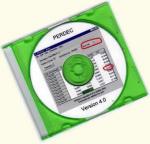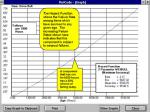|
|
 |
|
|
 We are proud to be the New Zealand distributors for the Banak range of Maintenance Engineering software. We are proud to be the New Zealand distributors for the Banak range of Maintenance Engineering software.
BANAK Inc. specializes in providing expert, best-of-practice strategies for the optimization of Physical Asset Management decisions. In addition to the classic maintenance text by Dr. Andrew K.S. Jardine: Maintenance, Replacement and Reliability (also available on CD-ROM), we offer Banak's software packages: AGE/CON, PERDEC and RELCODE .
|
 AGE/CON: Fleet (Vehicle) Replacement Decisions AGE/CON: Fleet (Vehicle) Replacement Decisions
AGE/CON calculates the best replacement time for your vehicles.
Management of fleet maintenance and vehicle replacement can be a complicated task. Best practice management will create the lowest costs with the highest efficiency so that each vehicle serves the overall business as best it can with a minimum of downtime disruption. Such management cannot rely on mere guesswork, but must find a way to balance the decreasing ownership costs of a vehicle with the increasing costs of operations and maintenance. An understanding of economic life models will allow a manager to apply mathematical calculations that will determine the ideal time to replace a vehicle, the year in which the total cost of a vehicle has its lowest value; before replacement time, repair costs are understood as necessary expenditures to maintain the equipment, and beyond the replacement time, repair creates an unnecessarily high cost for use of the vehicle.
AGE/CON applies your data through sound mathematical models.
The mathematical models needed to calculate ideal replacement time have been readily available for decades, notably in Dr. Jardine's text Maintenance, Replacement and Reliability. Dr. Jardine has also used seminars as a means of making the strategies accessible to maintenance managers and has provided consulting to a number of businesses/institutions seeking to improve efficiency. Such work with Montreal Transit in 1980 led to the development of the AGE/CON software.
AGE/CON simplifies your decision-making.
AGE/CON is designed for easy and accurate application of statistical analysis for optimizing maintenance and replacement decisions for mobile equipment. The manual available for the software provides definitions and explanations of the key terms and concepts that are important to this process of optimization, as well as displaying examples of problems that can be solved with use of AGE/CON. The fundamental principles behind the methodology are explored more exhaustively in research literature and training courses.
One advantage of AGE/CON is that the user only needs to input the necessary data for the calculations to be made by the software. Typical calculation would involve the following:
- the scope of time the user would like to consider for the data available
- the acquisition cost of purchasing a new vehicle in present day currency
- parameters of constant utilization, variable utilization (unplanned fluctuations), and planned changes to utilization (considering the workload to be assigned to a vehicle of a particular age) over the life of a vehicle
- inflation (the decrease in the purchasing value of a given currency as purchasing costs rise) with the consequent necessity of making calculations using a constant value for currency
- the discounting rate — considering the present time-value of future cash flows to obtain a fair comparison of future and present values
- calculation of taxes, such as through a tax depreciation rate and corporate tax rates (which may be appropriate for companies in the private sector)
- operations and maintenance costs — the relevant costs in establishing economic life, primarily including all values that may vary from year to year in the use of the equipment: regular maintenance, downtime of equipment caused by unexpected failure or planned time for maintenance or rebuilding, materials needed for operations (including fuel), and cost of holding inventory of spare parts
- resale values and resale rates to consider the value of dispensing with a vehicle in any given year.
AGE/CON provides an accurate and clear solution.
AGE/CON utilizes the data provided to calculate the EAC (the Equivalent Annual Cost).
The economic life model for an item considers an infinite chain of replacements or by modification for the first N cycles. Using the CRF (the Capital Recovery Factor), the values for total discounted cost can be converted into the EAC, the Equivalent Annual Cost, to better manage comparisons that will indicate the ideal year of service at which to replace the equipment. The lowest EAC value within a cycle represents the ideal year of replacement, based on the data that has been entered. Based on the calculations for EAC, AGE/CON advises the best year for replacement.
|
 PERDEC: Plant Machinery and PERDEC: Plant Machinery and
Equipment Replacement Decisions
PERDEC calculates the best replacement time for your equipment.
Best practice management of plant equipment will create the lowest costs
with the highest efficiency so that production continues with a minimum
of downtime disruption. Balancing the decreasing ownership costs of
equipment with the increasing costs of operations and maintenance is
crucial. An understanding of economic life models will allow a manager
to apply mathematical calculations that will determine the ideal time to
replace, the year in which the total cost of equipment has its lowest value;
before replacement time, repair costs are understood as necessary
expenditures to maintain the equipment, and beyond the replacement time,
repair creates an unnecessarily high cost for use.
PERDEC applies your data through sound mathematical models.
As with the foundation for the AGE/CON software, the mathematical
models needed to calculate ideal replacement time with PERDEC have
been readily available for decades, notably in Dr. Jardine's text
Maintenance, Replacement and Reliability. PERDEC is designed for
easy and accurate application of statistical analysis for optimizing
maintenance and replacement decisions for plant machinery and
equipment. The manual available for the software provides definitions and
explanations of the key terms and concepts that are important to this
process of optimization, as well as displaying examples of problems that
can be solved with use of PERDEC. The fundamental principles behind
the methodology are explored more exhaustively in research literature and
training courses.
PERDEC simplifies your decision-making.
One advantage of PERDEC is that the user only needs to input the
necessary data for the calculations to be made by the software. Typical
calculation would involve the following:
- the scope of time the user would like to consider for the data
available
- the acquisition cost of purchasing a new item of equipment in
present day currency
- parameters of constant utilization, variable utilization (unplanned
fluctuations), and planned changes to
- utilization (considering the workload to be assigned to equipment
of a particular age) over the life of the equipment
- inflation (the decrease in the purchasing value of a given
currency as purchasing costs rise) with the consequent necessity
of making calculations using a constant value for currency
- the discounting rate -- considering the present time-value of
future cash flows to obtain a fair comparison of future and
present values
- calculation of taxes, such as through a tax depreciation rate and
corporate tax rates (which may be appropriate for companies in
the private sector)
- operations and maintenance costs -- the relevant costs in
establishing economic life, primarily including all values that
may vary from year to year in the use of the equipment: regular
maintenance, downtime of equipment caused by unexpected
failure or planned time for maintenance or rebuilding, materials
needed for operations (including fuel), and cost of holding
inventory of spare parts
- resale values and resale rates to consider the value of dispensing
with an item of equipment in any given year
PERDEC provides an accurate and clear solution.
PERDEC utilizes the data provided to calculate the EAC (the Equivalent
Annual Cost). The economic life model for an item considers an infinite
chain of replacements or by modification for the first N cycles. Using the
CRF (the Capital Recovery Factor), the values for total discounted cost
can be converted into the EAC, the Equivalent Annual Cost, to better
manage comparisons that will indicate the ideal year of service at which to
replace the equipment. The lowest EAC value within a cycle represents
the ideal year of replacement, based on the data that has been entered.
Based on the calculations for EAC, PERDEC advises the best year for
replacement.
|
 RELCODE: RELCODE:
RelCode reveals the failure pattern of your machinery or vehicle components. Assessing the reliability of your equipment can require great specificity as you consider the various patterns by which the equipment can fail:
(UL)
Burn-in failures occur early in life and usually are the result of manufacture or installation defects.
Random failures are not related to age but usually to an external cause, like a stone through a windscreen.
Wearout occurs later in life, for example, the wear of a tyre tread.
Identifying the pattern of failure is often the key to understanding the root cause of failure and to selecting the most appropriate maintenance policy. RelCode uses statistical analysis to identify the failure pattern (or patterns) of your data and to convert this into useful management information. The software can identify if and when preventive replacement policy for components is worthwhile, determine appropriate inspection intervals for monitoring of failure, and advise requirements for spare parts inventory.
RelCode applies your data through sound mathematical models.
RelCode is designed by Dr. Nick Hastings, formerly Professor of Maintenance Engineering at Queensland University of Technology. The software incorporates the latest techniques in reliability data analysis. The foundation is Weibull Analysis, the original method for statistical analysis of reliability data. RelCode carries out traditional Weibull analysis, generates probability plots and derives Weibull parameters. Going beyond the basic Weibull plot, six different distribution models are fitted and a preferred model is automatically recommended, using advanced analytical methods.
RelCode simplifies your decision-making.
RelCode calculates the best preventive replacement intervals using published statistical techniques widely accepted by reliability and maintenance engineers. Sensitivity to cost data or policy variations is quickly analyzed. The software plots your reliability data against age on linear scales. The MTBF and the onset of wearout can be identified in components that initially have burn-in or random failures, leading to support for Reliability Centered Maintenance through the calculation of preventive replacement intervals and inspection intervals.
If you have no data on a particular component, RelCode allows you to make judgmental estimates of failure patterns and mean life and carries out analysis of useful information.
RelCode comes with an extensive Users Manual that helps you to present and analyze your data and to interpret the results at both management and technical levels.
RelCode provides an accurate and clear solution.
RelCode plots the data to reveal the relationship between reliability and age in a graphical, straight-forward and undistorted way. Ultimately, RelCode helps you to understand what is happening to your equipment and advises the best maintenance policies.
|
|
|

